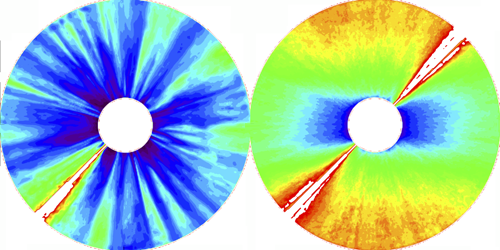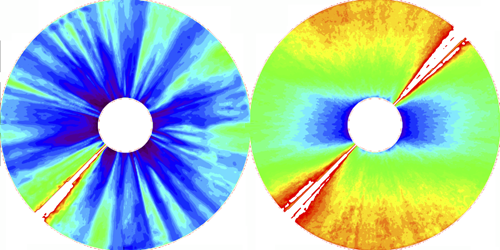2D Maps of Solar Wind
The Sun’s upper atmosphere, or corona, spews out streams of charged particles. Known collectively as the solar wind, these particles can whiz through space at speeds exceeding 800 km/s and can cause phenomena on Earth like aurorae and geomagnetic storms. Astrophysicists believe that the particles are accelerated by a combination of thermal excitation and magnetic fields, but better data on the distribution of particle velocities are needed to test solar wind models. Now Yong-Jae Moon of Kyung Hee University in Yongin, South Korea, and colleagues have improved the available data by producing maps of solar wind velocities with unprecedented spatiotemporal resolution.
The researchers are not the first to map solar wind velocities. However, previous studies did not fully characterize the solar wind velocity as a function of the Sun’s latitude. Also, those studies either covered a time span much shorter than the full 11-year solar cycle or had insufficient time resolution to capture daily variations. Using data acquired between 1999 and 2010 by the satellite-based Solar and Heliospheric Observatory (SOHO), Moon and colleagues produced 2D solar-wind-speed maps that cover all latitudes for nearly a complete solar cycle and with a temporal resolution range of between 1 day and 1 year.
The maps reveal that the solar-wind-speed distribution doesn’t vary much as a function of latitude when solar activity is highest, as in 2000. But the distribution is anisotropic when activity is low, as in 2009, with faster speeds measured at the poles and slower speeds at the equator. While these findings were expected from previous observations, the high spatial and temporal resolution of these new maps provide researchers with a more complete dataset for testing models of solar wind acceleration.
This research is published in Physical Review Letters.
–Matteo Rini
Matteo Rini is the Deputy Editor of Physics.





